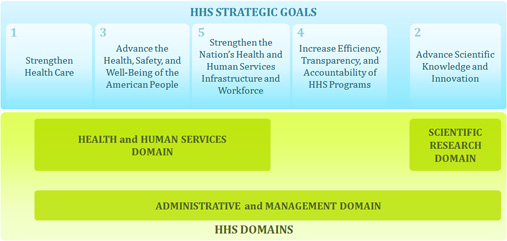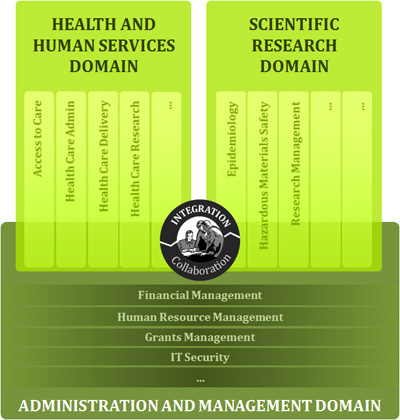Working with the HHS EA Program
HHS is a large and diverse organization, with a broad mission and corresponding functional responsibilities at both the Department level and, especially, among the Operating Divisions. To improve the business-driven perspective necessary for effective enterprise architecture development in support of the HHS mission, the HHS EA Program has adopted an approach defined in terms of Business Functions and Segments. Business Functions are grouped as communities of interest according to similarities in mission, goals, objectives, and commonality of services and business processes. HHS defines nine Business Areas:
HHS Business Areas (Click to enlarge)
HHS Domains (Click to enlarge)
The HHS Domains are defined as follows:
- Health and Human Services Domains: The Health and Human Services Domain (HHSD) includes IT investments that support access to care, quality health care, disease prevention, health promotion, reduction of health disparities, health administration, and federal programs that promote the economic and social well-being of families, children, individuals, and communities.
- Health and Human Services Domain IT PMO [Click Here]
- Scientific Research Domain: The Scientific Research Domain includes IT investments that directly support the common needs of the scientific research programs in basic, clinical, regulatory or applied science undertaken by HHS. This encompasses investments in: (1) the management of patient-oriented research; (2) the development of tools for the conduct of regulatory science to ensure the safety, quality or effectiveness of therapeutic products; (3) the development of common and generalizable tools for the analysis of scientific data; (4) the construction of shared or distributed high-performance computing infrastructure dedicated to the analysis of experimental data; (5) the development of open access repositories of clinical, epidemiological or biological data and open access scientific literature or scientific experts knowledge systems.
- Administrative and Management Domains: The Administration and Management Domain includes those IT projects, programs and assets that support acquisitions, budget, facilities, finance, grants administration, human resources, and any other administrative and management function. This domain includes the HHS IT infrastructure and IT security projects, programs, and assets required to enable the digital and analog services that support and secure the health and human services, scientific research, and administrative and management activities of HHS.
- Health and Human Services Domains: The Health and Human Services Domain (HHSD) includes IT investments that support access to care, quality health care, disease prevention, health promotion, reduction of health disparities, health administration, and federal programs that promote the economic and social well-being of families, children, individuals, and communities.
Domains are decomposed into multiple functions and segments. The segment-based approach helps to make enterprise architecture more manageable and consistent across HHS and its operational divisions. This business-driven perspective is also consistent with the EA guidance provided by OMB. The HHS EA Program’s incorporation of segment-based EA development principles helps to establish appropriate governance boundaries and dimensions for EA development, use, and analysis.
The HHS Domains map directly to the HHS Strategy Goals as depicted in the following image.

To improve the completeness of the HHS enterprise architecture, HHS adopted a common approach and a structured methodology. This method describe all phases of segment development, processes and activities to be followed; data collection templates, tools, and guidelines; and recommendations and guidelines for producing specific artifacts and work products. The methodology provides a structured, repeatable set of processes to guide the collection of architecture-related information and production of segment-related artifacts and other EA outputs. This information has many possible uses, including business process analysis and re-engineering, and support for decision making related to proposed IT investments intended to build or acquire a solution to address one or more business needs as defined in the segment’s target architecture.






